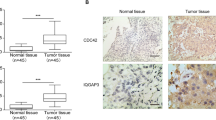Summary
The purpose of this study was to investigate the impact of leucine-rich repeats and immunoglobulin-like domains 3 (LRIG3) on the biological features of bladder cancer cell lines. The plasmids of over-expressed LRIG3 and the blank plasmid serving as control were transfected into the bladder cancer cell lines, T24, EJ and BIU-87, and the expression levels of LRIG3 mRNA and protein were detected by using real-time PCR and Western blotting. The changes in the cell cycle and apoptosis were examined by using flow cytometry. The invasive ability was measured by Transwell assay, and CCK-8 assays were used to measure the proliferation of cells. As compared with the control group, the LRIG3 mRNA and protein expression levels in LRIG3 cDNA-transfected group were raised significantly (P<0.05). The average number of cells with up-regulated LRIG3 passing through the inserted filter was decreased significantly as compared with the control group (P<0.05). Up-regulation of LRIG3 also could inhibit proliferation and induce apoptosis of T24, EJ and BIU-87 cells. Except BIU-87, the T24 and EJ cells transfected with LIRG3 cDNA were arrested in G0/G1 phase compared to the control group (P<0.05). In conclusion, the over-expression of LRIG3 could influence the cell cycle and invasion, inhibit proliferation and induce apoptosis in the three bladder cancer cell lines.
Similar content being viewed by others
References
Jemal A, Siegel R, Ward E, et al. Cancer statistics, 2008. CA Cancer J Clin, 2008,58(2):71–96
Nilsson J, Vallbo C, Guo D, et al. Cloning, characterization, and expression of human LIG1. Biochem Biophys Res Commun, 2001,284(5):1155–1161
Holmlund C, Nilsson J, Guo D, et al. Characterization and tissue-specific expression of human LRIG2. Gene, 2004,332(12):35–43
Guo D, Holmlund C, Henriksson R, et al. The LRIG gene family has three vertebrate paralogs widely expressed in human and mouse tissues and a homolog in Ascidiacea. Genomics, 2004,84(1):157–165
Laederich MB, Funes-Duran M, Yen L, et al. The leucine-rich repeat protein LRIG1 is a negative regulator of ErbB family receptor tyrosine kinases. J Biol Chem, 2004,279(45):47 050–47 056
Gur G, Rubin C, Katz M, et al. LRIG1 restricts growth factor signaling by enhancing receptor ubiquitylation and degradation. EMBO J, 2004,23(16): 3270–3281
Shattuck DL, Miller JK, Laederich M, et al. LRIG1 is a novel negative regulator of the Met receptor and opposes Met and Her2 synergy. Mol Cell Biol, 2007,27(5): 1934–1946
Reifenberger G, Ichimura K, Reifenberger J, et al. Refined mapping of 12q13-q15 amplicons in human malignant gliomas suggests CDK4/SAS and MDM2 as independent amplification targets. Cancer Res, 1996,56(22): 5141–5145
Hedman H, Nilsson J, Guo D, et al. Is LRIG1 a tumour suppressor gene at chromosome 3p14.3? Acta Oncol, 2002,41(4):352–354
Cai M, Han L, Chen R, et al. Inhibition of LRIG3 gene expression via RNA interference modulates the proliferation, cell cycle, cell apoptosis, adhesion and invasion of glioblastoma cell (GL15). Cancer Lett, 2009,278(1): 104–112
Katayama M, Sanzen N, Funakoshi A, et al. Laminin gamma2-chain fragment in the circulation: a prognostic indicator of epithelial tumor invasion. Cancer Res, 2003,63(1):222–229
Wernicke M, Pineiro LC, Caramutti D, et al. Breast cancer stromal myxoid changes are associated with tumor invasion and metastasis: a central role for hyaluronan. Mod Pathol, 2003,16(2):99–107
Kurokawa H, Katsube K, Podyma KA, et al. Heparanase and tumor invasion patterns in human oral squamous cell carcinoma xenografts. Cancer Sci, 2003,94(3):277–285
Yarden Y. The EGFR family and its ligands in human cancer. signalling mechanisms and therapeutic opportunities. Eur J Cancer, 2001,37(Suppl 4):S3–8
Pedersen MW, Meltorn M, Damstrup L, et al. The type III epidermal growth factor receptor mutation. Biological significance and potential target for anti-cancer therapy. Ann Oncol, 2001,12(6):745–760
Ljungberg B, Gafvels M, Damber JE. Epidermal growth factor receptor gene expression and binding capacity in renal cell carcinoma, in relation to tumor stage, grade and DNA ploidy. Urol Res, 1994,22(5):305–308
Ye F, Gao Q, Xu T, et al. Upregulation of LRIG1 suppresses malignant glioma cell growth by attenuating EGFR activity. J Neurooncol, 2009,94(2):183–194
Li F, Ye ZQ, Guo DS, et al. Suppression of bladder cancer cell tumorigenicity in an athymic mouse model by adenoviral vector-mediated transfer of LRIG1. Oncol Rep, 2011,26(2):439–446
Author information
Authors and Affiliations
Corresponding author
Rights and permissions
About this article
Cite this article
Qi, Y., Chang, L., Li, H. et al. Over-expression of LRIG3 suppresses growth and invasion of bladder cancer cells. J. Huazhong Univ. Sci. Technol. [Med. Sci.] 33, 111–116 (2013). https://doi.org/10.1007/s11596-013-1081-3
Received:
Published:
Issue Date:
DOI: https://doi.org/10.1007/s11596-013-1081-3




